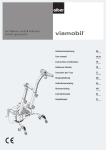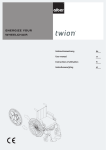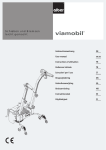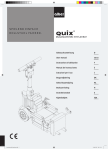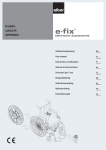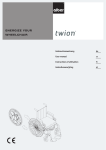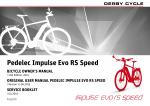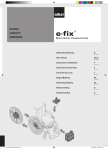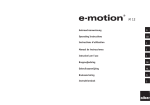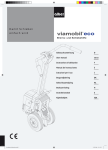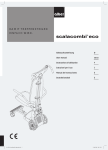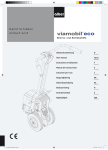Download User Manual
Transcript
Damit Schieben einfach wird Brems- und Schiebehilfe Umschlag.indd 5 Gebrauchsanweisung D User manual GB/US Instructions d’utilisation F Instruktionsbok S 26.05.2010 12:57:57 Das viaplus ist klassifiziert als Gerät Typ B. Umschlag.indd 6 26.05.2010 12:57:58 1 2 3 5 4 9 8 10 11 12 6 7 13 18 17 15 18 16 14 19 20 21 25 22 23 24 Umschlag.indd 1 26.05.2010 12:57:54 Contents 1. Introduction 1.1 Important safety instructions – please observe carefully at all times 1.2 Purpose and intended use of viaplus 1.3 Permissible operating conditions / locations of operation 1.4 Standard scope of delivery 1.5 Technical data 1.6 The main elements at a glance 2 2 2 2 2 3 4 2. Start-up 2.1 Extending drive wheels 2.2 Selecting speed at the control unit 2.3 Forward travel 2.4 Reverse travel 2.5 Traversing obstacles 2.6 Switching off driving mode 2.7 Retracting drive wheels 2.8 Anti-tippers 5 6 7 7 7 9 10 10 10 3. Battery pack 3.1 Direct charging of battery pack 3.2 Charging battery pack through the viaplus 3.3 Changing fuse in battery pack 3.4 General battery information 11 11 11 12 12 4. Transport 4.1 Removing viaplus from wheelchair 4.2 Attaching viaplus to wheelchair 4.3 Transport instructions for viaplus and wheelchair 13 13 14 16 5. Storage 16 6. Fault signals 6.1 LED status indicator continuously on 6.2 LED status indicator flash codes 6.3 What should I do if ... 17 17 17 18 7. Safety and hazard information 7.1 Safety instructions 7.2 Obstacles 7.3 Danger areas and hazardous situations 19 19 20 20 8. Maintenance, care and disposal 8.1 Charging battery pack 8.2 Cleaning 8.3 Disposal 8.4 Re-use 8.5 Maintenance 20 20 21 22 22 22 9. Warranty and liability 9.1 Warranty for defects 9.2 Guarantee of durability 9.3 Liability 23 23 23 23 24.0001.4.99.01 As of: 03.05.2010 GA-V12_GB.indd 1 26.05.2010 13:04:00 8 1. Introduction 1.1 Important safety instructions – please observe carefully at all times viaplus is a push and braking aid to be used exclusively by the person accompanying the wheelchair user. The viaplus must under no circumstances be used as an electric drive system by the wheelchair user alone. For safety reasons, the viaplus must only be operated by persons who • have been instructed in its handling and operation • are physically and mentally in a position to operate the device properly and according to the given operating conditions and situations. Instruction in the handling and operation of the device is included in the scope of delivery. Please contact your specialist dealer or Alber representative to arrange for a training session. The instruction is free of charge. If you feel a little unsure how to handle the viaplus, please contact your specialist dealer or Alber representative for advice. For the operation of the viaplus, observe the specifications of the wheelchair manufacturer (e.g. maximum slope, air pressure of tyres, etc.), and strictly adhere to the operating instructions of the wheelchair. Never exceed any of the specified limit values. Before using a mobile phone or similar device, always secure the wheelchair on level ground and switch off the viaplus. Avoid strong electromagnetic fields (for example near large electric motors), as they might interfere with the viaplus. When in operation, the viaplus might under certain circumstances interfere with other electrical equipment such as anti-shoplifting barriers in department stores. ! Therefore do not start the viaplus before you have been properly instructed in its operation by an authorised specialist dealer or Alber representative! 1.2 Purpose and intended use of viaplus The viaplus is an add-on drive attached to a manually operated wheelchair to assist the attendant of a wheelchair user in pushing the wheelchair. It thus enables people to take long drives without tiring as the effort for pushing and braking is greatly reduced. The electric motor of the viaplus makes it easy to push the wheelchair up a slope. When travelling down a slope, the viaplus reduces the speed to the set level, which makes operation of the wheelchair safer even on steep slopes. Before using the viaplus, carefully read all safety instructions and hazard information in chapter 7. 1.3 Permissible operating conditions / locations of operation • Observe the permissible operating conditions of the wheelchair to which the viaplus is attached (see wheelchair manual). Any limits regarding the operation of the wheelchair (e.g. maximum climbing capability, maximum permissible height of obstacles, max. load, etc.) must be strictly adhered to. • Avoid using the wheelchair on soft ground (e.g. loose chipping, sand, mud, snow, ice or deep puddles). • Always observe the safety and hazard information in chapter 7. 1.4 Standard scope of delivery • Drive unit • Control unit • Battery charger • Battery pack • Operating instructions • Warranty information GA-V12_GB.indd 2 26.05.2010 13:04:00 1.5 Technical data Drive unit Range: Speed: Slope: Motor power rating: max. 16 km(*) continuously adjustable to max. 6 km/h (forward travel) or max. 3 km/h (reverse travel) max. 10 % (for user weight of 120 kg) 200 W Battery pack Batteries: Rated operating voltage: Operating temperature: 2 x 12 V, 12 Ah, approved by IATA and DOT for aircraft transport 24 V ambient temperature range (approx. - 25 °C to + 50 °C) Weight of components Battery pack: Drive unit: Control unit: Battery charger: Total weight: 6.0 kg 10.7 kg 0.3 kg 0.5 kg 20.5 kg (*) The range depends on the terrain and the prevailing driving conditions. The specified maximum range is valid for optimum travel conditions (level terrain, fully recharged batteries, ambient temperature around 20 °C, smooth travel, etc.). The viaplus conforms to the requirements laid down in the European Medical Device Directive 93/42/EEC. We reserve the right to modify the design and technology of our products to incorporate the latest developments. Battery charger For technical information and user instructions, please refer to the separate operating manual of the battery charger. GA-V12_GB.indd 3 26.05.2010 13:04:01 8 1.6 The main elements at a glance (please fold out overview drawing in document cover) Drive unit Plug Socket for control unit plug Charger socket at chassis Bolt Spacer ring Pedal Wheel Mounting fork 1 2 3 4 5 6 7 8 Control unit Control unit housing Control button LED status indicator Driving lever Plug 9 10 11 12 13 Battery pack Plug contact Fuse, 25 A Hinged cover Charger socket at battery pack Battery pack housing 14 15 16 17 18 Battery charger Charging plug Charger housing Charge indicator 19 20 21 Wheelchair Bracket Quickpin Mounting fork Cross strut of wheelchair 22 23 24 25 GA-V12_GB.indd 4 26.05.2010 13:04:01 2. Start-up The viaplus is supplied to you ready for operation. This means that • a special bracket [22] to which the viaplus is attached has been mounted to both sides of the wheelchair, • the viaplus has been fitted to the wheelchair, • the viaplus control unit has been mounted on the push handles of the wheelchair, • a battery pack [18] to power the viaplus has been attached below the wheelchair. Your viaplus is thus ready for operation and can be started and operated by following the instructions in the chapters below. 18 ! The installation of the bracket [22] and all necessary adjustments to the viaplus must be carried out by Ulrich Alber GmbH, its representative or your authorised specialist dealer. ! Regularly check the bracket [22] to ensure that it is firmly secured to the wheelchair. If a screw connection has become loose, contact your specialist dealer or Alber representative to have it retightened. It might be necessary to readjust the device. ! Ulrich Alber GmbH provides brackets of various design (single-part or multiple-part brackets). The bracket shown in figures in this operating manual might therefore deviate from that attached to your bracket. ! Before starting the viaplus, carefully read the operating manual and in particular chapter 7 (safety and hazard information). 22 GA-V12_GB.indd 5 26.05.2010 13:04:01 8 2.1 Extending drive wheels When not in use, the drive wheels [7] of the viaplus are located approx. 2 cm above the ground. This allows you to move the wheelchair without the viaplus. To activate the electric push and braking aid, you must first lower the two wheels [7] to the ground. To do this, proceed as follows: • Hold the wheelchair by its handles. • Using the tip of your foot, fold down the pedal [6] of the viaplus from its resting position. • When the pedal [6] is in its centre position, push it down firmly with your foot to extend the two retracted drive wheels [7]. • When the wheels [7] are extended, swivel the pedal [6] back to its initial resting position. 6 7 ! After each use, swivel the pedal [6] back to its resting position! If the pedal [6] is not swivelled to its resting position, the viaplus could malfunction and the braking behaviour of the viaplus might be impaired! GA-V12_GB.indd 6 26.05.2010 13:04:02 2.2 Selecting speed at the control unit The scale positions on the button [10] are assigned as follows: • Position “0”: the viaplus is switched off; the LED status indicator [11] is off. • Positions “1” to “6”: preset speed (continuously adjustable from “1” = 1 km/h to “6” = 6 km/h); the LED status indicator [11] is on. • Position “R”: the brake of the viaplus is disabled and the drive wheels are set to idle rolling mode. The LED status indicator [11] is on. To select the speed at which you wish to operate the wheelchair, turn the button [10] to the respective position (1-6). To switch off the viaplus, turn the button [10] to position “0”. 10 11 2.3 Forward travel • Hold the viaplus with both hands by the handles of the wheelchair. • Push the driving lever [12] slowly down to the stop, using your thumb. As long as the driving lever [12] is pushed down, the viaplus drives the wheelchair forward. When the driving lever [12] is released, it automatically returns to its initial (centre) position. The viaplus is thus stopped and the brakes are applied. 12 2.4 Reverse travel • Hold the viaplus with both hands by the handles of the wheelchair. • Push the driving lever [12] slowly up to the stop. As long as the driving lever [12] is pushed up, the viaplus drives the wheelchair backwards. When the driving lever [12] is released, it automatically returns to its initial (centre) position. The viaplus is thus stopped and the brakes are applied with an audible click. 12 GA-V12_GB.indd 7 ! When starting the viaplus for the first time, operate it at minimum speed (set speed select button to position „1“) and familiarise yourself with the drive behaviour of the device. You can then gradually increase the speed and operate the device in forward and reverse mode. After a few minutes, you will have developed a feel for the safe operation of the viaplus. ! The viaplus is protected against inadvertent drive actuation. It is therefore not possible to first actuate the driving lever [12] and then switch on the viaplus. If the driving lever is actuated before the viaplus is switched on, the device is blocked and the LED status indicator [11] flashes 6 times (for fault codes, see chapter 6.2). In this case, you must switch off the viaplus by turning the button [10] to position „0“ and then switch it on again. 26.05.2010 13:04:03 8 GA-V12_GB.indd 8 ! While operating the add-on drive, keep an eye on the LED status indicator [11] for possible fault signals (see also chapter 6.2). If the indicator flashes at uniform intervals during driving, the battery pack of the viaplus needs to be recharged. Terminate your trip with the viaplus as soon as possible. If this is not possible, switch off the viaplus as soon as this is possible (see chapter 2.6) and retract the drive wheels (see chapter 2.7). You can then push the wheelchair without the assistance of the add-on drive. ! When driving along bends, turning the wheelchair or driving uphill or downhill, the centre of gravity of the wheelchair might be shifted so that there is a risk that the wheelchair might tip over to the side. Therefore proceed with extreme care and reduce the speed of the addon drive! ! For safety reasons, the brakes are automatically applied if the wheelchair is moving too fast (pushed or rolling freely). ! Never secure the driving lever [12] in a position using a strap or similar object. Only operate the driving lever with your thumb. ! Do not attach bags or similar objects to the handlebars of the wheelchair or to the driving lever [12], as this could prevent the lever from returning to its neutral position. 26.05.2010 13:04:03 2.5 Traversing obstacles Obstacles higher than 3 cm (such as kerbs) must be traversed backwards with the viaplus switched off. • Retract the drive wheels [7] (see chapter 2.7). • Turn the button [10] to position “R” to set the viaplus to idle rolling mode. The brake of the viaplus is disabled and the drive wheels are set to idle rolling mode. The LED status indicator [11] is constantly on. • Lift the wheelchair by its handles and pull it backwards over the obstacle. After having traversed the obstacle: • Lower the drive wheels [7] again (see chapter 2.1). • Select the desired speed at the control unit [9] (see chapter 2.2) and continue your trip. 10 GA-V12_GB.indd 9 ! Never switch to idle rolling mode when driving up or down a slope. There is a risk that the wheelchair could be inadvertently set in motion! ! When climbing or descending across kerbs, observe the maximum obstacle height specified by the wheelchair manufacturer. 11 26.05.2010 13:04:04 8 2.6 Switching off driving mode To switch off the driving mode, turn the button [10] to position “0”. The viaplus is now switched off and the LED status indicator [11] is off. i 10 When not in use, switch off the viaplus to prevent unnecessary discharge of the battery pack. 11 2.7 Retracting drive wheels After switching off the viaplus, you must retract the drive wheels [7]. To do this, proceed as follows: • Ensure that the viaplus is switched off (see chapter 2.6). • Using the tip of your foot, fold down the pedal [6] of the viaplus from its resting position. • When the pedal [6] is in its centre position, push it down firmly with your foot to retract the two lowered drive wheels [7]. • After the wheels [7] are fully retracted, fold the pedal [6] up to its resting position. 6 10 ! After each use, swivel the pedal [6] back to its resting position! If the pedal [6] is not switched to its resting position, the add-on drive might not work properly and its braking function could be impaired! 7 2.8 Anti-tippers We strongly recommend equipping the wheelchair with anti-tippers, as they greatly enhance safety when driving on level ground. When climbing slopes of more than 8 %, the use of anti-tippers (installed in pairs) is mandatory. Only attach the anti-tippers supplied by the wheelchair manufacturer. GA-V12_GB.indd 10 26.05.2010 13:04:05 3. Battery pack The viaplus is powered by a battery pack [18] attached to the wheelchair. The battery pack is located in a battery pack bag (see diagram) or in a metal battery box. 18 The battery pack should normally remain attached to your wheelchair. It can however be removed from the bag or box, if you need to lift or transport the wheelchair. To charge the battery pack, follow the instructions below. 3.1 Direct charging of battery pack • Fold the hinged cover [16] of the battery pack down by 90 degrees. • Insert the plug [19] of the battery charger [20] into the charger socket [17] of the battery pack. • Insert the mains plug of the battery charger into a mains socket. The battery pack is now being charged, and the charge indicator [21] at the charger is lit in orange. • When the charge indicator [21] at the charger changes to green, the battery pack is fully charged. 17 19 After charging: • Disconnect the mains plug of the battery charger [20] from the mains socket. • Disconnect the plug [19] of the battery charger from the charger socket [17] of the battery pack. • Fold the hinged cover [16] up by 90 degrees and close it. 16 19 3 3.2 Charging battery pack through the viaplus • Remove the rubber cap of the charger socket [3]. • Insert the plug [19] of the battery charger [20] into the charger socket [3]. • Insert the mains plug of the battery charger into a mains socket. The battery pack is now being charged, and the charge indicator [21] at the charger is lit in orange. • When the charge indicator [21] at the charger changes to green, the battery pack is fully charged. After charging: • Disconnect the mains plug of the battery charger [20] from the mains socket. • Disconnect the plug [19] of the battery charger from the charger socket [3] of the viaplus. • Seal the charger socket [3] with the rubber cap. ! ! GA-V12_GB.indd 11 11 For safety reasons, the viaplus cannot be started while it is being charged. The viaplus can only be switched on after the plug [19] has been disconnected. For the charging of the battery pack, observe the instructions in the operating manual of the charger. 26.05.2010 13:04:05 8 15 3.3 Changing fuse in battery pack At the rear of the battery pack [18]: • Disconnect the plug [1] from the socket [14] (see chapter 4.1) so that there is no electric connection between the battery pack and the viaplus. At • • • the front of the battery pack [18]: Fold the hinged cover [16] of the battery pack down by 90 degrees. Remove the defective fuse [15] from the battery pack. Replace the defective fuse with a new 25 A blade-type fuse (available from your electrical or medical equipment supplier). • Fold the hinged cover [16] up by 90 degrees. 16 12 At the rear of the battery pack [18]: • Reconnect the battery pack to the viaplus by inserting the plug [1] into the socket [14] at the battery pack (see chapter 4.2). ! If fuses must be replaced frequently, the viaplus might be defective. Contact your authorised specialist dealer or Alber representative to arrange for a technical inspection of your viaplus. 3.4 General battery information The batteries of the viaplus require no maintenance and are rechargeable. Their service life depends heavily on the depth of discharge. You can prolong the service life of your batteries by recharging them regularly. • Avoid completely discharging the battery pack. Recharge the battery pack of the viaplus after each partial discharge, i.e. after every use of the device. • Lead batteries are subject to what is known as self-discharge. If the battery pack is not in use for a prolonged period of time (without charging), its capacity can become reduced. Therefore regularly recharge the battery pack, if it is not in use for some time. Normally, the full battery capacity is recovered after a number of charging/discharging cycles. • If the battery pack is handled incorrectly, there is a risk of liquid electrolyte spilling out. This liquid can cause injury to skin and damage to clothing. • In the event of contact of the electrolyte with eyes or skin, immediately rinse the affected area with clean water and consult a doctor. • Do not burn battery packs and protect them against naked flames as they can explode when exposed to heat. • Protect the battery pack against water. Do not immerse it as this could result in short circuits and permanent damage to the batteries. • Do not short-circuit the battery pack. Short circuits result in high currents, which can cause damage to the battery pack and/or the viaplus. Short circuits can also cause fire. • When the batteries have reached the end of their service life, return them to your Alber representative or authorised specialist dealer for proper disposal. ! GA-V12_GB.indd 12 The battery pack of your viaplus can be charged/discharged in any chosen position. As the batteries are as safe as dry cells, they are approved by DOT and IATA for transport in airplanes. 26.05.2010 13:04:06 4. Transport Normally, the viaplus is permanently attached to the wheelchair. If necessary for transport, the system can however be dismantled into its individual components. To do this, proceed as follows: 13 4.1 Removing viaplus from wheelchair At the chassis: • Switch off the viaplus (see chapter 2.6). • Hold the plug [13] by the release sleeve and pull it from the socket [2] at the chassis. • The control unit remains attached to the handle of the wheelchair. At the rear of the battery pack [18]: • Using your thumb and index finger, push together the two locking mechanisms on the plug [1] of the viaplus. • Disconnect the plug [1] from the socket [14] of the battery pack. • Remove the battery pack from the bag or box. 1 At the viaplus: • Retract the drive wheels (see chapter 2.7). • Hold the viaplus at the pedal [6]. 6 22 23 GA-V12_GB.indd 13 13 At • • • the wheelchair (both sides): Push in the releasing device at the centre of the quickpin [13], using your thumb. Pull the quickpin [13] from the bracket [22]. The viaplus is now detached from the wheelchair and can be removed by holding it by the pedal. • To transport the unit, ensure that all components of the viaplus are properly stowed away. • Observe the instructions for the transport of the viaplus and the wheelchair in chapter 4.3. 26.05.2010 13:04:07 8 4.2 Attaching viaplus to wheelchair To attach the viaplus to the wheelchair, we recommend holding the unit by its pedal [6] and sliding it under the wheelchair. At the wheelchair (both sides): • Ensure that the mounting forks [8] engage at the cross strut of the wheelchair [25] as shown in the diagram. 8 25 14 24 22 • Slide the bolts [4] of the viaplus into the mounting forks [24] of the bracket [22]. The setting ring [5] attached to the bolt [4] must thereby be located inside the bracket [22] (i.e. towards the centre of the wheelchair). • Press down the releasing device at the centre of the quickpin [23] and move the quickpin to the stop through the mounting fork [24] and along the inserted bolt [4]. 23 5 4 23 ! 22 Ensure that the viaplus is properly attached to the two brackets [22] mounted on the wheelchair. It must be impossible to remove the viaplus from the mounting forks [24] without first removing the quickpin [23]! 4 5 GA-V12_GB.indd 14 26.05.2010 13:04:07 At the chassis: • Insert the plug [13] of the control unit into the socket [2] at the chassis. To position the plug correctly, you might need to turn it a little. 2 13 At • • • 1 the rear of the battery pack housing [18]: Place the battery pack in the bag or box and secure it with the Velcro strap. Insert the plug [1] into the socket [14] of the battery pack. Check whether the plug [1] is properly engaged in the socket [14] so that it cannot inadvertently become loose. 15 Your viaplus is now ready for operation and can be started. 14 GA-V12_GB.indd 15 26.05.2010 13:04:08 8 4.3 Transport instructions for viaplus and wheelchair • To transport the wheelchair, follow the instructions of the wheelchair manufacturer. You might need to secure the wheelchair or certain components. • During transport, the viaplus or its dismantled parts must be properly secured so that they do not pose a risk to the driver or passengers in the event of a sudden brake manoeuvre. • Please check whether there are specific statutory regulations regarding the transport of wheelchairs, wheelchair wheels or add-on drives in your country and strictly adhere to these regulations. • For safety reasons, it is strictly forbidden to sit in the wheelchair while travelling in another vehicle. • Always adhere to the statutory requirements. • Ulrich Alber GmbH and its agents shall not be liable for any damage resulting from non-compliance with these instructions. 16 5. Storage • To store the viaplus, place it on a surface that is easy to clean. • If you wish to store the viaplus for a prolonged period of time, you must keep the device and in particular the battery pack in a dry environment, preferably at room temperature (+15 °C to 25 °C). • Recharge the battery pack every 30 days with the supplied battery charger. This ensures that your viaplus is working properly even after prolonged storage. • After the battery pack has been charged, disconnect the charger from the power mains. • The batteries consist of dry cells. If stored and handled correctly, they are leak-proof and do not require any maintenance apart from regular recharging. For more details regarding the batteries used in the viaplus, see chapter 3.4. • If the viaplus is to be stored for a prolonged period of time together with the wheelchair, we recommend lifting the drive wheels from the ground by operating the pedal (see chapter 2.7). • Switch on the viaplus once a month and move the wheelchair a few meters forward and back to prevent seizing of the brake and similar damage. GA-V12_GB.indd 16 26.05.2010 13:04:08 6. Fault signals 6.1 LED status indicator continuously on As a rule, the LED status indicator [11] is continuously on, if the viaplus is working properly. If the battery pack is nearly empty, its residual capacity might under certain circumstances not be large enough to activate a flash code. In this case, the LED status indicator remains continuously on until the battery pack is fully discharged. Recharge the battery. 6.2 LED status indicator flash codes Faults in the operation of your viaplus are indicated by means of flash codes of the LED status indicator [11]. Codes: LED flash code (flashing 1x) (flashing 3x) ! GA-V12_GB.indd 17 Remedy The battery pack of the viaplus is discharged. Recharge the battery pack as soon as possible. The battery pack has been automatically Switch the viaplus off and on again recharged to its full capacity by the motor (see chapter 2.2 / 2.6). during downhill travel. Continue the downhill travel at the lowest possible speed. If possible, avoid prolonged steep descents while the battery pack is fully recharged. (flashing 6x) (flashing 9x) Cause of problem The locking device to prevent unintentional drive function activation has noticed that you have actuated the driving lever [12] while switching on the viaplus. Release the driving lever [12] and switch off the viaplus. Then switch on the viaplus again without actuating the driving lever [12]. Internal error Switch the viaplus off and on again (see chapter 2.2 / 2.6). If the error persists, the viaplus cannot be used. Contact your authorised specialist dealer or Alber representative. 17 If one of the fault codes listed in the table above occurs, the electronic system of the viaplus has detected a fault or defect in the device. In such a case, it is not possible to operate the add-on drive. Contact your authorised specialist dealer or Alber representative. 26.05.2010 13:04:09 8 6.3 What should I do if ... Some common faults can be easily rectified as follows: 18 What should I do if ... Remedy Contact ... the battery pack cannot be recharged This defect can only be repaired at the factory your authorised specialist dealer or Alber representative the viaplus cannot be switched on Check the following: – Is the battery pack recharged? – Are the fuses in the battery pack defective? the viaplus cannot be switched on, although the battery pack is fully recharged and all fuses are OK This defect can only be repaired at the factory your authorised specialist dealer or Alber representative the viaplus suddenly stops Switch the viaplus off and then on again. If the problem persists, the device is defective and must be returned to the factory your authorised specialist dealer or Alber representative the viaplus makes a noise but fails to move ! GA-V12_GB.indd 18 Check whether the drive wheels are touching the ground or have inadvertently been retracted (see chapter 2.1) If a fault that is not listed in the above table occurs, the add-on drive is normally disabled. Contact your authorised specialist dealer or Alber representative for advice. 26.05.2010 13:04:09 7. Safety and hazard information To ensure safe operation and use of your viaplus, strictly adhere to the following instructions. 7.1 Safety instructions Before using the viaplus: • Before using the viaplus to drive up or down a slope, practice the operation of the add-on drive on level ground. • The viaplus must only be attached to wheelchairs that have been approved by Ulrich Alber GmbH for operation with the add-on drive. • The bracket for the viaplus must be installed by Ulrich Alber GmbH or your authorised specialist dealer. It is forbidden to modify the bracket. If modifications are necessary, contact Ulrich Alber GmbH, an Alber representative or your authorised specialist dealer. • When using the viaplus, always strictly adhere to the operating instructions of the wheelchair. • The viaplus must only be operated by the attendant. As there is a risk that the wheelchair might topple over when driving on slopes, the viaplus must not be used as a self-drive device. The attendant must at all times be in a position to prevent tipping over of the wheelchair with passenger. Please note that the wheelchair might tip over forward or backwards. • We strongly recommend equipping the wheelchair with anti-tippers. When climbing slopes of more than 8%, the use of anti-tippers (installed in pairs) is mandatory. • The parking brakes of the wheelchair to which the viaplus is attached must be positioned in such a way that they can be easily operated by the attendant while pushing the wheelchair. • Before setting the wheelchair in motion, check the drive wheels. If the tyres are worn to the limit (see chapter 8.2), do not use the viaplus and change the tyres. • Ensure that the air pressure in the wheelchair tyres corresponds to that prescribed by the wheelchair manufacturer. • The viaplus should be inspected and serviced every two years by Ulrich Alber GmbH, a company representative or your authorised specialist dealer (see chapter 8.5). 19 When using the viaplus, observe the following: • Before using the viaplus to drive up or down a slope, practice the operation of the add-on drive on level ground. • To start the viaplus, set the speed select button to the lowest speed and then gradually increase it to the desired walking speed. • The viaplus must not be used to drive on slopes of more than 10 %. Under no circumstance must the maximum permissible slope specified by the wheelchair manufacturer by exceeded. • Before driving down a slope, readjust the speed at the button to ensure that it is not greater than the walking speed of the attendant. • Do not drive up or down slopes in idle rolling mode. • Before approaching stairs, precipices or steep slopes, always switch off the viaplus add-on drive. • While the viaplus is switched on, each actuation of the driving lever [12] is converted into a drive command. It is therefore imperative that inadvertent actuation is prevented. When stopping or waiting in potentially dangerous positions (e.g. while waiting at a traffic light, in front of slopes or ramps of any type), switch off the viaplus and do not touch the driving lever [12]. • Ensure that children do not touch the driving lever [12] or set the viaplus in motion. • Do not attach any objects (shopping bags, etc.) directly on or near the control unit! Such objects might actuate the driving lever, which could result in inadvertent drive pulses. • When driving on pavements, keep a safe distance (preferably the width of the wheelchair) from the kerb. • To drive over kerbs, always switch off the viaplus and push/pull the wheelchair backwards. Lift the wheelchair by its handles and not by the viaplus. When driving over kerbs, observe the maximum climbing height specified by the wheelchair manufacturer. • Avoid using the wheelchair on soft ground (e.g. loose chipping, sand, mud, snow, ice or deep puddles). • Never leave the viaplus unattended, even if it is switched off. If this cannot be avoided, remove the battery pack to prevent unauthorised operation of the viaplus. • During prolonged trips, the drive system of the viaplus might become hot. Do not touch the drive system immediately after a long trip (e.g. to place the viaplus in the car, etc.). • The performance of the viaplus can be affected by electromagnetic fields, produced for example by mobile phones. Therefore switch off the add-on drive if a mobile phone is used in the vicinity of the wheelchair. • The viaplus might under certain circumstances interfere with other electrical equipment such as anti-shoplifting barriers in department stores. GA-V12_GB.indd 19 26.05.2010 13:04:09 8 After use of the viaplus, observe the following: • When not in use, the viaplus must be switched off to prevent inadvertent triggering of drive pulses when the driving lever [12] is touched and to prevent complete discharge of the battery. • Recharge the battery pack of your viaplus as soon as possible after each trip. 7.2 Obstacles Obstacles that are higher than 3 cm, such as kerbs, must be traversed backwards. For details, see chapter 2.5. ! 20 Always observe the maximum permissible obstacle height specified in the operating manual of the wheelchair! 7.3 Danger areas and hazardous situations The attendant operating the viaplus must decide in each case whether it is safe to use the add-on drive for the intended trip. Issues such as driving experience and physical strength must thereby be taken into account. Before undertaking a trip, check the viaplus wheels for damage and proper inflation. Also check the battery charge level and the control elements. These safety checks and the experience of the attendant are of special importance in connection with operation of the add-on drive in or near the following danger areas: • Quay walls, berths and marinas, paths and areas near water, bridges and dykes without railings. • Narrow footpaths, steep slopes (e.g. ramps), narrow paths along slopes, mountain paths. • Narrow and / or steep / inclined paths along main roads or near precipices. • Paths covered with leaves, snow or ice. • Ramps and lifting platforms of vehicles. ! It is forbidden to use the viaplus to drive along slopes of more than 10 %. The basic safety requirements include proper tyre profiles, correct wheelchair tyre pressure, firm ground and a maximum load of 120 kg on the wheelchair. When driving along bends, turning the wheelchair or driving uphill or downhill, the centre of gravity of the wheelchair might be shifted so that there is a risk that the wheelchair might tip over to the side. Therefore proceed with extreme caution and reduce the speed of the add-on drive! Special caution is required when crossing main roads, crossroads and level railway crossings! Never push the wheelchair at a small angle over rails, as the wheels could be jammed in the rails! Proceed with special caution when driving over ramps or lifting platforms of vehicles. Before lifting or lowering the wheelchair on the ramp or lifting platform, switch off the viaplus. Do not actuate the driving lever [12]. Apply the hand brakes of the wheelchair. This prevents inadvertent movement or drive commands. If the ground is wet, the tyres adhesion might be poor so that there is a risk of slipping. Adjust your driving behaviour accordingly. 8. Maintenance, care and disposal 8.1 Charging of battery pack Your viaplus uses power in all operating modes. Avoid fully discharging the battery pack, as this could cause damage to the batteries. We recommend recharging the battery pack immediately after every use. To charge the battery pack, only use the mains charger supplied with your viaplus. This charger is switched automatically when the battery pack is fully recharged, avoiding overcharging. For detailed instructions regarding the battery pack, see also chapter 3.4. GA-V12_GB.indd 20 26.05.2010 13:04:09 8.2 Cleaning To clean the viaplus, use only conventional household detergents. • Clean the drive, handlebar and battery pack only with a moist (not wet) cloth. • Clean the bracket attached to the wheelchair with a moist (not wet) cloth. • Regularly clean the drive wheel, using a dry brush or compressed air cleaner. Your viaplus is a low-maintenance device. With the exception of the tyres, the add-on drive does not contain wear parts. To ensure that the drive or braking force respectively of your viaplus is transferred properly, the tyres must not be worn beyond the specified wear limit. New tyres (see figure A) have a proper tyre profile and thus ensure optimised contact pressure and safe drive behaviour. If the profile and the side radiuses [R] are not visible any more, the tyre of your viaplus is worn (see figure B). At this point, the diameter [X] of the tyre is 94 mm. The tyre must be replaced without delay as there might not be sufficient contact pressure to the ground. To change the tyre, contact your authorised specialist dealer or Alber representative. 21 A R R X ! Should you observe a deterioration of the drive behaviour of your viaplus (e.g. irregular rolling, slipping wheels), contact your authorised specialist dealer or Alber representative to check the tyres. ! All service and repair work on the viaplus must be carried out by the manufacturer, an Alber representative or an authorised specialist dealer. If you encounter any problems with your viaplus, contact your authorised specialist dealer or Alber representative. B GA-V12_GB.indd 21 26.05.2010 13:04:10 8 8.3 Disposal The add-on drive, its battery pack and accessories are durable products. They might however contain substances that are hazardous to the environment, if the parts are disposed of in locations (e.g. landfills) that are not destined for the disposal of such materials according to the applicable statutory regulations. The product is labelled in accordance with European Directive 2002/96/EC (WEEE Directive) with a crossed-out waste bin symbol, reminding you that it must be recycled. Please take care of the environment and return the product at the end of its service life to your local recycling centre. As this product is not covered by the regulations of the WEEE Directive in all European countries, please inform yourself of the applicable waste disposal regulations in your country. In Germany, the product is for example classified as a transport vehicle and is thus not covered by the Electrical and Electronic Equipment Act implementing the WEEE Directive. Alternatively, return the product to your authorised specialist dealer or Alber representative for proper and safe disposal. 22 8.4 Re-use If your viaplus has been provided to you by your health insurance company and you do not need it any longer, please contact your health insurer, Alber representative or authorised specialist dealer, as your add-on drive can be given to somebody else. Before re-using the viaplus, its safety must be checked. The brackets with which the viaplus is attached to the wheelchair can be easily and quickly removed by the authorised dealer or Alber representative and mounted on another. Before re-using the viaplus, clean it as described in chapter 8.2 and disinfect the control unit [9] and the housing of the battery pack [18]. To do this, use a product based on isopropyl alcohol that is suitable for wiping disinfection. The product must have an alcohol concentration of 70 %. Observe the use instructions of the product. 8.5 Maintenance Your viaplus is a low-maintenance device. You should nevertheless check all attachment and accessory parts at regular intervals to ensure that these parts are firmly seated. At least every 2 years, you must have your viaplus examined by an expert (technical safety inspection) to check its performance and safety. During such an inspection, damage and signs of wear and fatigue that are not visible to the eye and might occur during use of the system can be detected. To arrange a safety inspection, contact your authorised specialist dealer or Alber representative. GA-V12_GB.indd 22 26.05.2010 13:04:10 9. Warranty and liability 9.1 Warranty for defects Ulrich Alber GmbH guarantees that the viaplus is free of defects at the time of delivery. The warranty expires 24 months after the date of delivery of the viaplus. 9.2 Guarantee of durability Ulrich Alber GmbH grants a 24-month guarantee of durability for your viaplus (exception: the guarantee period of the battery pack is 12 months). The guarantee of durability shall not apply to: • devices whose serial number have been tampered with or removed, • wear parts such as brakes, tyres and control elements, • defects caused by normal wear, incorrect handling including non-compliance with the instructions in this operating manual, accidents, reckless damage, damage caused by fire, water, force majeure and other events that are outside the control of Ulrich Alber GmbH, • parts that might need to be serviced or replaced as part of normal use (e.g. replacement of tripped fuses, change of tyre), • device inspection without detection of a fault or defect. 23 9.3 Liability Ulrich Alber GmbH as the manufacturer of the viaplus add-on drive shall not be liable for its safety, if • the viaplus is handled or operated incorrectly, • the viaplus has not been serviced at the prescribed two-year intervals by an authorised specialist dealer, Alber representative or Ulrich Alber GmbH, • the viaplus has been operated in contravention to the instructions in this operating manual, • the viaplus has been operated with insufficient battery charge, • the viaplus has been repaired or modified by a person not authorised to carry out such work, • third-party parts have been attached to the viaplus, • components of the viaplus have been removed. GA-V12_GB.indd 23 26.05.2010 13:04:10 8 Ihre Alber-Vertretung / Your Alber representative / Votre représentation Alber / Vostra rappresentanza Alber / Su representación Alber / Din Alber representant / Din Alber-agenturene / Uw distributeur Alber / Deres Alber-repræsentation Ulrich Alber GmbH Vor dem Weißen Stein 21 72461 Albstadt-Tailfingen Telefon +49 (0)7432 2006-0 Telefax +49 (0)7432 2006-299 [email protected] www.alber.de www.alber.de Umschlag.indd 4 26.05.2010 12:57:55




























